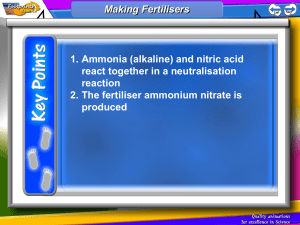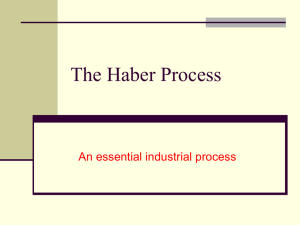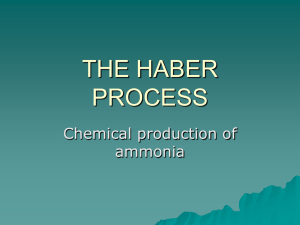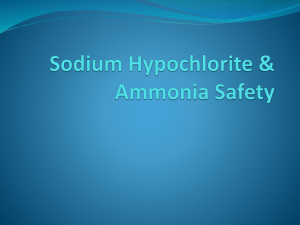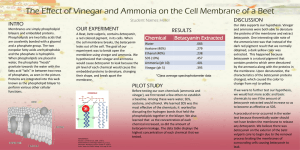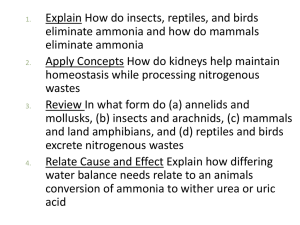Haber Process - WordPress.com
advertisement
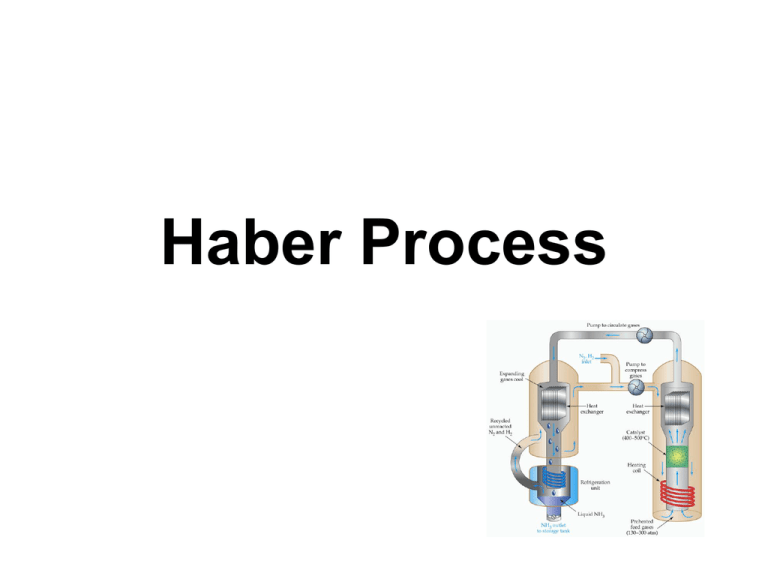
Haber Process Flow Chart of the Haber Process At the beginning of the 20th century there was a shortage of naturally occurring, nitrogen-rich fertilizers, such as Chile saltpetre, which prompted the German Chemist Fritz Haber, and others, to look for ways of combining the nitrogen in the air with hydrogen to form ammonia, which is a convenient starting point in the manufacture of fertilizers .This process was also of interest to the German chemical industry as Germany was preparing for World War I and nitrogen compounds were needed for explosives. The hydrogen for the ammonia synthesis was made by the water-gas process (a Carl Bosch invention) which involves blowing steam through a bed of red hot coke resulting in the separation of hydrogen from oxygen. The nitrogen was obtained by distillation of liquid air, then by cooling and compressing air. Enough steam is used to react with about 45% of the methane (CH4), the rest of the methane is reacted with air: Ni catalyst ----------> 700oC CH4(g) + H2O(g) 2CH4(g) + O2(g) + 4N2(g) (air) CO(g) + 3H2(g) Ni catalyst ---------> 2CO(g) + 4H2(g) + 4N2(g) All the carbon monoxide (CO) in the mixture is oxidised to CO2 using steam and an iron oxide catalyst: CO(g) + H2O(g) iron oxide catalyst ------------------> H2(g) + CO2(g) The carbon dioxide (CO2) is removed using a suitable base so that only the nitrogen gas (N2) and hydrogen gas (H2) remain and are used in the production of ammonia (NH3). In ammonia production the hydrogen and nitrogen are mixed together in a ratio of 3:1 by volume and compressed to around 200 times atmospheric pressure. In 1909 Fritz Haber established the conditions under which nitrogen, N2(g), and hydrogen, H2(g), would combine using • medium temperature (~500oC) • very high pressure (~250 atmospheres, ~351kPa) • a catalyst (a porous iron catalyst prepared by reducing magnetite, Fe3O4). Osmium is a much better catalyst for the reaction but is very expensive. This process produces an ammonia, NH3(g), yield of approximately 10-20%. The Haber synthesis was developed into an industrial process by Carl Bosch. The reaction between nitrogen gas and hydrogen gas to produce ammonia gas is exothermic, releasing 92.4kJ/mol of energy at 298K (25oC). N2(g) + 3H2(g) 2NH3 (g) heat, pressure, catalyst H = -92.4 kJ mol-1 Increasing the pressure causes the equilibrium position to move to the right resulting in a higher yield of ammonia since there are more gas molecules on the left hand side of the equation (4 in total) than there are on the right hand side of the equation (2). Increasing the pressure means the system adjusts to reduce the effect of the change, that is, to reduce the pressure by having fewer gas molecules. Decreasing the temperature causes the equilibrium position to move to the right resulting in a higher yield of ammonia since the reaction is exothermic (releases heat). Reducing the temperature means the system will adjust to minimise the effect of the change, that is, it will produce more heat since energy is a product of the reaction, and will therefore produce more ammonia gas as well However, the rate of the reaction at lower temperatures is extremely slow, so a higher temperature must be used to speed up the reaction which results in a lower yield of ammonia. As the temperature increases, the equilibrium constant decreases as the yield of ammonia decreases. Temperature (oC) Keq 25 6.4 x 102 200 4.4 x 10-1 300 4.3 x 10-3 400 1.6 x 10-4 500 1.5 x 10-5 Rate considerations: A catalyst such as an iron catalyst is used to speed up the reaction by lowering the activation energy so that the N2 bonds and H2 bonds can be more readily broken. Increased temperature means more reactant molecules have sufficient energy to overcome the energy barrier to reacting (activation energy) so the reaction is faster at higher temperatures (but the yield of ammonia is lower as discussed above). A temperature range of 400-500oC is a compromise designed to achieve an acceptable yield of ammonia (10-20%) within an acceptable time period. At 200oC and pressures above 750atm there is an almost 100% conversion of reactants to the ammonia product. Since there are difficulties associated with containing larger amounts of materials at this high pressure, lower pressures of around 200 atm are used industrially. By using a pressure of around 200atm and a temperature of about 500oC, the yield of ammonia is 10-20%, while costs and safety concerns in the building and during operation of the plant are minimized During industrial production of ammonia, the reaction never reaches equilibrium as the gas mixture leaving the reactor is cooled to liquefy and remove the ammonia. The remaining mixture of reactant gases are recycled through the reactor. The heat released by the reaction is removed and used to heat the incoming gas mixture. Uses of Ammonia Agricultural industries are the major users of ammonia, representing nearly 80% of all ammonia produced in the United States. Ammonia is a very valuable source of nitrogen that is essential for plant growth. Depending on the particular crop being grown, up to 200 pounds of ammonia per acre may be applied for each growing season. Ammonia is used in the production of liquid fertilizer solutions which consist of ammonia, ammonium nitrate, urea and aqua ammonia. It is also used by the fertilizer industry to produce ammonium and nitrate salts. Ammonia and urea are used as a source of protein in livestock feeds for ruminating animals such as cattle, sheep and goats. Ammonia can also be used as a preharvest cotton defoliant, an anti-fungal agent on certain fruits and as preservative for the storage of high-moisture corn. Dissociated ammonia is used in such metal treating operations as nitriding, carbonitriding, bright annealing, furnace brazing, sintering, sodium hydride descaling, atomic hydrogen welding and other applications where protective atmospheres are required. Uses of Ammonia Ammonia is used in the manufacture of nitric acid; certain alkalies such as soda ash; dyes; pharmaceuticals such as sulfa drugs, vitamins and cosmetics; synthetic textile fibers such as nylon, rayon and acrylics; and for the manufacture of certain plastics such as phenolics and polyurethanes. The petroleum industry utilizes ammonia in neutralizing the acid constituents of crude oil and for protection of equipment from corrosion. Ammonia is used in the mining industry for extraction of metals such as copper, nickel and molybdenum from their ores. Ammonia is used in several areas of water and wastewater treatment, such as pH control, in solution form to regenerate weak anion exchange resins, in conjunction with chlorine to produce potable water and as an oxygen scavenger in boiler water treatment. Ammonia is used in stack emission control systems to neutralize sulfur oxides from combustion of sulfur-containing fuels, as a method of NOx control in both catalytic and non-catalytic applications and to enhance the efficiency of electrostatic precipitators for particulate control. Ammonia is used as the developing agent in photochemical processes such as white printing, blue printing and in the diazo duplication process. Ammonia is a widely used refrigerant in industrial refrigeration systems found in the food, beverage, petro-chemical and cold storage industries. Ammonia is used in the rubber industry for the stabilization of natural and synthetic latex to prevent premature coagulation. The pulp and paper industry uses ammonia for pulping wood and as a casein dispersant in the coating of paper. The food and beverage industry uses ammonia as a source of nitrogen needed for yeast and microorganisms. The decomposition of ammonia serves as a source of hydrogen for some fuel cell and other applications. Ammonia is used by the leather industry as a curing agent, as a slime and mold preventative in tanning liquors and as a protective agent for leathers and furs in storage. Weak ammonia solutions are also widely used as commercial and household cleaners and detergents. Uses Nitric Acid production The most important single use of ammonia is in the production of nitric acid. A mixture of one part ammonia to nine parts air is passed over a platinum gauze catalyst at 850 °C, whereupon the ammonia is oxidized to nitric oxide. Ammonia solution is also used as universal indicator that could be used to test for different gases that require a universal indicator solution to show the gases were present. 4 NH3 + 5 O2 → 4 NO + 6 H2O The catalyst is essential, as the normal oxidation (or combustion) of ammonia gives dinitrogen and water: the production of nitric oxide is an example of kinetic control. As the gas mixture cools to 200–250 °C, the nitric oxide is in turn oxidized by the excess of oxygen present in the mixture, to give nitrogen dioxide. This is reacted with water to give nitric acid for use in the production of fertilizers and explosives. Fertilizer In addition to serving as a fertilizer ingredient, ammonia can also be used directly as a fertilizer by forming a solution with irrigation water, without additional chemical processing. This later use allows the continuous growing of nitrogen dependent crops such as maize (corn) without crop rotation but this type of use leads to poor soil health. Refrigeration Ammonia's thermodynamic properties made it one of the refrigerants commonly used in refrigeration units prior to the discovery of dichlorodifluoromethane[15] in 1928, also known as Freon or R12. But ammonia is toxic, gaseous, irritant, and corrosive to copper alloys, and over a kilo is needed for even a miniature fridge. With an ammonia refrigerant, the ever present risk of an escape brings with it a risk to life. However data on ammonia escapes has shown this to be an extremely small risk in practice, and there is consequently no control on the use of ammonia refrigeration in densely populated areas and buildings in almost all jurisdictions in the world. Its use in domestic refrigeration has been mostly replaced by CFCs and HFCs in the first world, which are more or less non-toxic and non-flammable, and butane and propane in the 3rd world, which despite their high flammability do not seem to have produced any significant level of accidents. Ammonia has continued to be used for miniature and multifuel fridges, such as minibars and caravan fridges. These ammonia absorption cycle domestic refrigerators do not use compression and expansion cycles, but are driven by temperature differences. However the energy efficiency of such refrigerators is relatively low. Today the smallest refrigerators mostly use solid state peltier thermopile heat pumps rather than the ammonia absorption cycle. Ammonia continues to be used as a refrigerant in large industrial processes such as bulk icemaking and industrial food processing. Since the implication of haloalkanes being major contributors to ozone depletion, ammonia is again seeing increasing use as a refrigerant.

